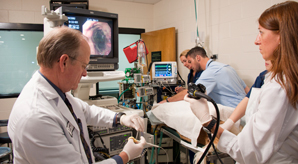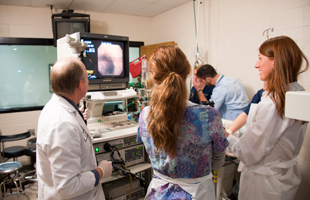Small Animal Endoscopy Group
Patients at the Veterinary Teaching Hospital have access to one of the nation's leading teams in veterinary endoscopy. But their owners may be confused about what endoscopy is and what it means to their pet's veterinary care and treatment.
Endoscopy in general means looking inside the body for medical evaluations or treatments using an endoscope. An endoscope has a rigid or flexible tube (depending on the procedure), a light to illuminate the area, a lens, an eyepiece and can have additional medical instruments to aid in procedures. Special video cameras allow viewing of the exam or procedure on a television screen as well as recording of the exam.
Veterinarians use endoscopy for many procedures that once required more invasive surgery, as well as for diagnosing medical problems. Specific procedures have different names, but all fall in the family of endoscopy. Some examples include:
- Laparoscopy – used to treat or diagnose medical conditions in the abdominal or pelvic cavity
- Arthroscopy – interior of a joint
- Bronchoscopy – lower respiratory tract
- Cystoscopy – urinary tract
- Enteroscopy – gastrointestinal tract
Veterinarians can use endoscopic techniques to remove health-threatening, non-food items from an animal's stomach (some recent cases include a boa constrictor that swallowed a beach towel and lots of dogs swallowing squeaky toys); spay female dogs; evaluate the respiratory, gastrointestinal or urinary system as well as internal organs; take biopsies; perform prophylactic gastropexy (where the stomach is tacked to the abdominal wall) to prevent gastric dilation-volvulus in at-risk dogs (commonly known as torsion or bloat); remove urinary bladder stones; treat fluid build-up in the lungs; perform cryptorchid surgery (removal of an undescended testicle): and much more.
If your animal is scheduled for laparoscopy procedure, they will be anesthetized and two to three small incisions (1/2 inch long) will be made to allow for equipment access channels. One or two channels allow endoscopic tools to be passed in for surgical procedures or to take biopsy samples.
Endoscopic procedures are minimally invasive, complications are rare, and pain and recovery time is reduced as compared to other more invasive surgical procedures. Some procedures, including evaluation of the digestive system and respiratory system, are nonsurgical and require no incisions, with a very quick recovery from anesthesia.
Ever since Dr. David Twedt began the endoscopy program at Colorado State University more than 30 years ago, our veterinarians have been constantly developing new endoscopic procedures to enhance the veterinary care and treatment of your pet. Recent breakthroughs include new surgical treatments developed by Dr. Eric Monnet and the introduction of minimally invasive spaying for female dogs. In addition to patient care and research, the small animal endoscopy group educates veterinary students in minimally invasive surgery techniques, and provides continuing education to practicing veterinarians from around the world who wish to expand their endoscopy skills.


